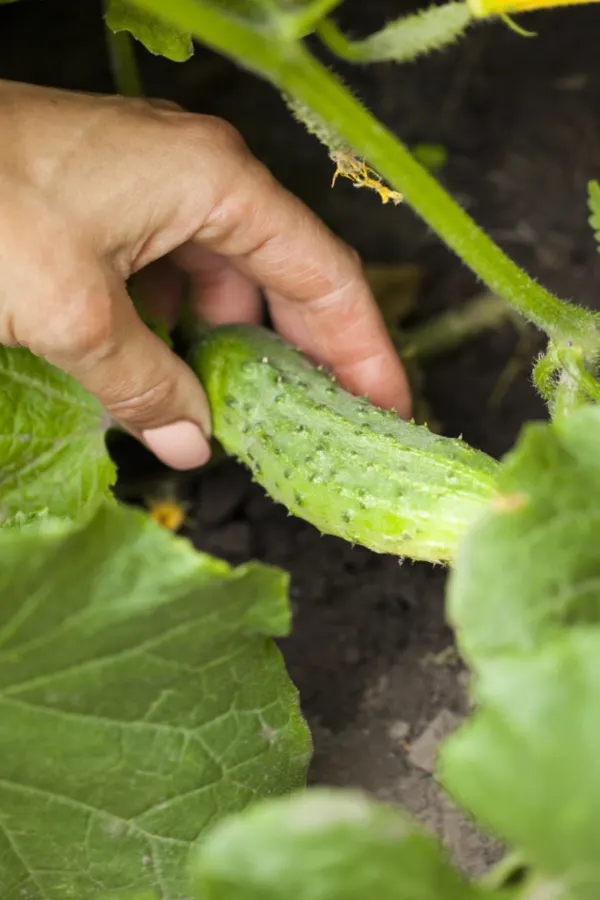If you are looking to grow your best crop ever of cucumbers for fresh eating, delicious pickles and more, then you are going to love today’s article that covers the 4 biggest secrets for growing cucumbers anywhere – no matter if you grow in a garden, raised beds, containers – or even straw bales!
Cucumbers can be one of the most rewarding vegetable plants to grow – and at the same time, one of the most frustrating. When plants are healthy and strong, they can flower and produce almost at will. But when they begin to struggle, whether from a lack of nutrients, disease, or from an attack by pests, they can go downhill in an instant.
But here’s the good news – keeping cucumbers healthy, strong and producing all season long is well within any gardener’s reach. Especially if you simply follow a few key planting and growing tips that all but ensure a big harvest!
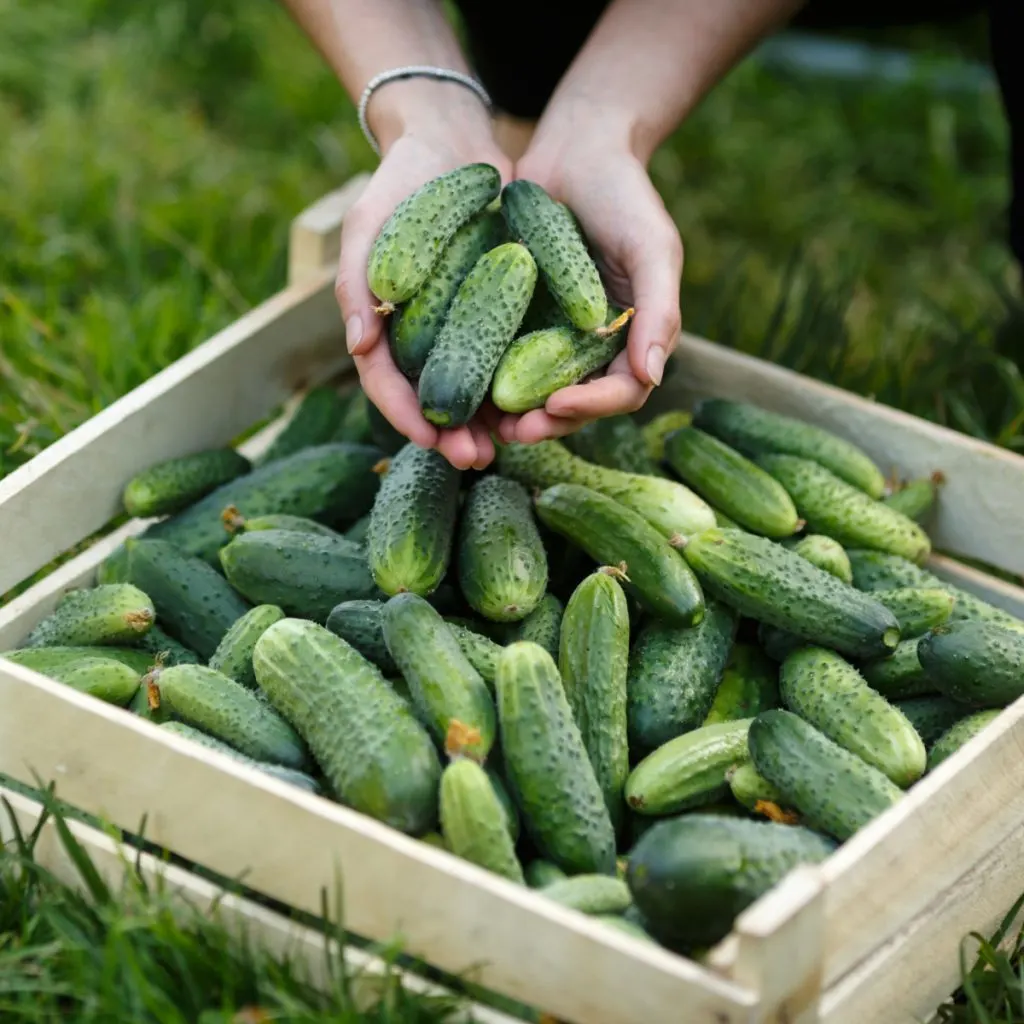
The 4 Biggest Secrets To Growing Cucumbers!
#1 Plant Your Cucumbers With Seeds & Not Transplants
One of the biggest mistakes gardeners make when planting cucumbers is to grow or purchase transplants for their garden instead of simply planting from seed. It’s actually far better to directly plant seeds wherever you will grow in place of transplants.
Why? Because it eliminates so many early issues that injure, stress, or completely take out young plants. When you grow from seed, the seedlings sprout and grow being accustomed to the soil and temperature. But transplants, especially when they first go in the ground, struggle with early season dampness and the cooler temperatures.
Because of that, they often sit in the soil with little growth. And when they do, pests and disease are quick to pounce. Allow your soil to warm up and instead, plant by seed. You will be rewarded with fast growing plants that most likely will produce cucumbers before transplants ever can – and for far longer as well!
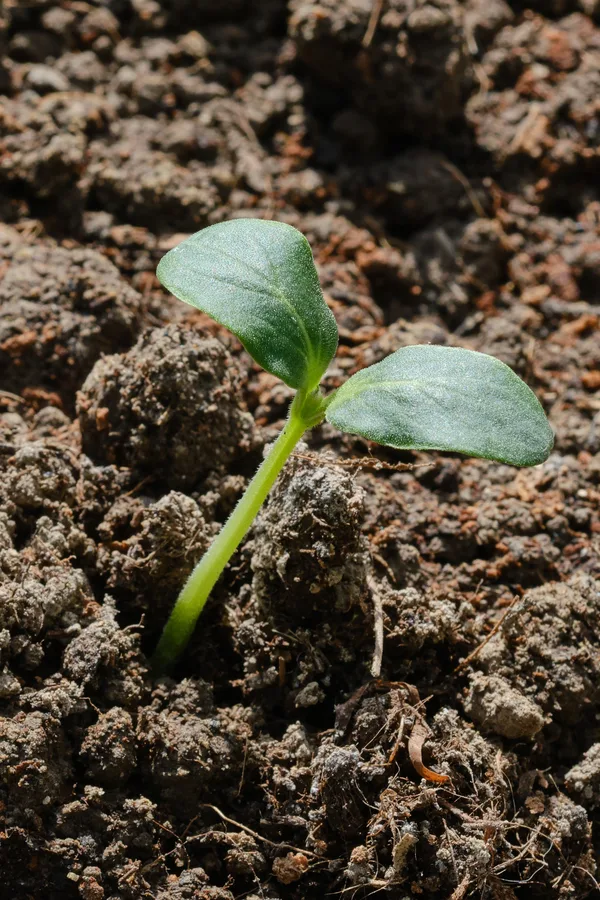
Last but not least, always use fresh seeds. Seeds that have been saved for several years lose their vitality and strength. They can take longer to germinate and struggle to grow to full maturity. Affiliate Product Link: Sow Right Seeds – National Pickling Cucumber Seeds for Planting – Non-GMO
#2 Mulch Your Plants Early – The 4 Biggest Secrets To Growing Cucumbers
One of the biggest ways to help cucumber plants is with mulch – and lots of it! After planting seeds, place a light 1 inch coat of mulch over your planting area. This will help keep moisture in to help seeds germinate. It also will help regulate the soil temperature and stop weed seeds from finding a home.
Once your seeds germinate and grow, continue to add more thickness to the layer of mulch. Keep the mulch a few inches away from the main stems to avoid any potential of rotting. A three to four inch layer of straw, shredded leaves or grass clippings underneath cucumber plants is best.
Not only will this continue to hold valuable moisture in and stop competing weeds from stealing nutrients from your plants, that thick layer of mulch will help protect young cucumbers from touching the soil as they form. And that can keep them safe from rot and other issues. As vines grow out, have mulch underneath them.
Listen In Below To Our Podcast For Even More Advice On Growing Cucumbers!
#3 Don’t Forget To Fertilize! The 4 Biggest Secrets To Growing Cucumbers
If you want healthy productive plants and a big harvest – you need to fertilize. And even more importantly, on a regular basis with the right type of fertilizer!
Cucumbers, like many common garden crops, need a steady of supply of nutrients to thrive. Unfortunately, even the most fertile of soil begins to lose its nutrients as plants grow. This happens in a traditional garden setting – and even more when your grow cucumbers in containers or raised beds.
But how you fertilize matters. In fact, it can matter in quite a big way. It’s better to give cucumber plants steady, lower doses of nutrients than a large jolt of fertilizer every month or so. Cucumber plants perform best when given a light application of fertilizer every 10 to 14 days. And the best way to do this is by using liquid versions that absorb via the roots and foliage.
Picking The Right Fertilizer
As with many fruiting plants, it’s best to use a liquid fertilizer with a higher rate of phosphorous and potassium than nitrogen. Nitrogen powers growth, but phosphorous and potassium help the plant produce blooms and fill with fruit.
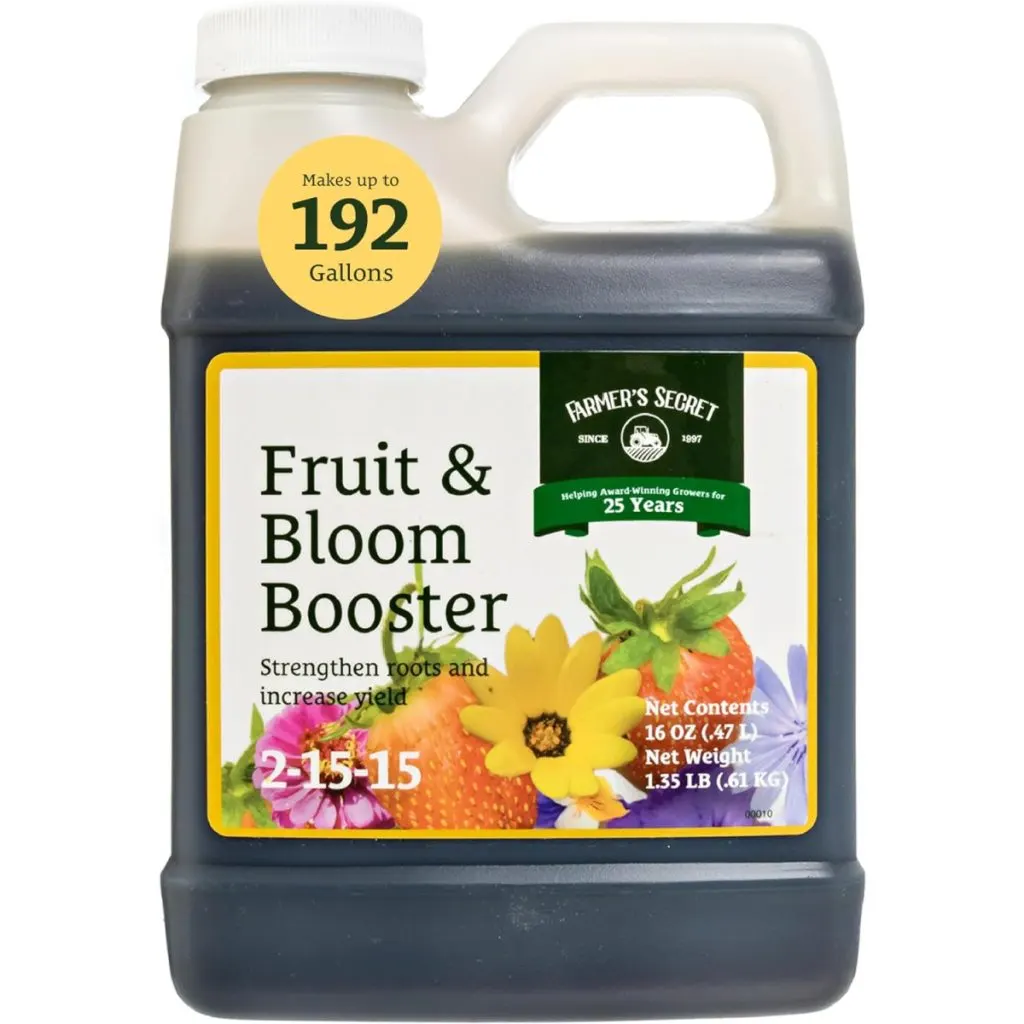
Look for a liquid product with an N-P-K ratio of 2-15-15 to 5-15-15. This will give your cucumber plants a small dose of nitrogen for steady growth, but plenty of phosphorous and potassium for big bloom and fruit production. Affiliate Product Link: Farmer’s Secret Fruit & Bloom Booster Fertilizer
Fertilize plants every 10 to 14 days, mixing the liquid fertilizer with water at half of the recommended strength. This will allow you to fertilize more often and supply a constant low and slow feed.
#4 Water Smart! The 4 Biggest Secrets To Growing Cucumbers
It’s plain and simple, cucumber plants love water! In fact, the slender long fruits are actually made up of nearly 95% water! And that means they need a steady supply of it to produce as many cucumbers as possible.
Cucumber plants are one of the first plants to dry out, whether it be in a garden or container setting. Their vines, stems and foliage all begin to wilt quickly when water is in short supply.
Unfortunately, wilting is more than just unsightly. It also causes serious stress to the plant, and to future bloom and fruit production levels. But even more, it makes them more susceptible to attack from disease and pests as they weaken.
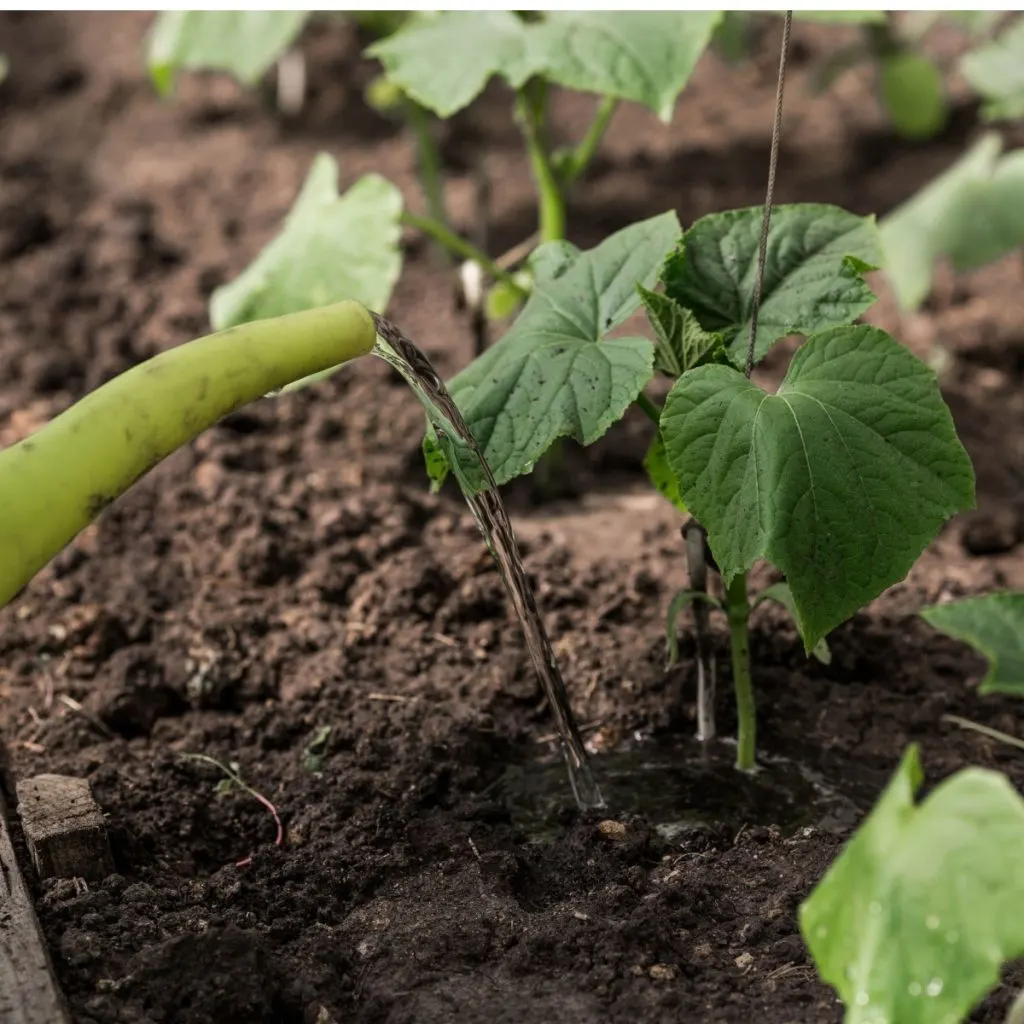
The Best Way To Water
So how much water do cucumber plants need? Most vegetable plants (tomatoes, peppers, corn, etc.) can survive and thrive on one inch of water per week. But cucumbers need nearly double that at around two inches for maximum health and production.
That means watering plants 2 to 3 times per week when rain isn’t falling. And even more if you are growing in pots or containers. As for how much water for each plant, a general rule of thumb is to use 1/4 to 1/2 gallon of water per plant, per watering.
Finally, when it comes to watering, as with nearly everything in life, too much of a good thing can be bad. Be careful not to overwater. Too much water will lead to yellowing of the foliage, and can cause mildew and other issues. Soggy roots swell. And when they do, they cannot absorb nutrients from the soil.
Always check the soil before watering for moisture. One of the easiest and best ways to see if your cucumbers need water is with an inexpensive soil meter. The probes of the meter go down to the root level and give you an instant read of the moisture level. Affiliate Product Link: XLUX Soil Moisture Meter
Pick Your Plants Often – The 4 Biggest Secrets To Growing Cucumbers
Finally, one of the most important things you can do to have a big crop is to pick your cucumbers early and often! In fact, the easiest way to slow or even stop cucumber production is by allowing fruit to stay on the vine too long.
When overloaded with too many cucumbers, or when too many fruits are left to grow excessively large on a vine, the plant stops using energy to produce new blooms and fruit in order to continue growing the existing fruit larger.
And we all know that over-sized cucumbers are not the tastiest of fruits! Pick early and often to keep plants producing at their maximum levels all summer long. The more you pick, the more chance you have more blooms and more great cucumbers!
Here is to having your best year ever growing cucumbers! Happy Gardening – Jim and Mary.
Old World Garden
Jim and Mary Competti have been writing gardening, DIY and recipe articles and books for over 15 years from their 46 acre Ohio farm. The two are frequent speakers on all things gardening and love to travel in their spare time.
As always, feel free to email us at thefarm@owgarden.com with comments, questions, or to simply say hello! You can sign up for our free email list in the subscribe now box in the middle of this article. Follow us on Facebook here : OWG Facebook. This article may contain affiliate links.

